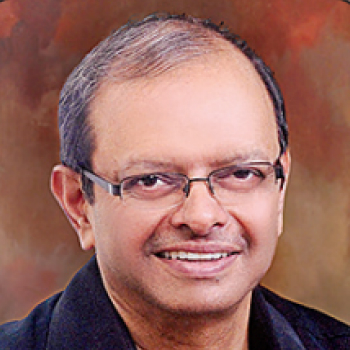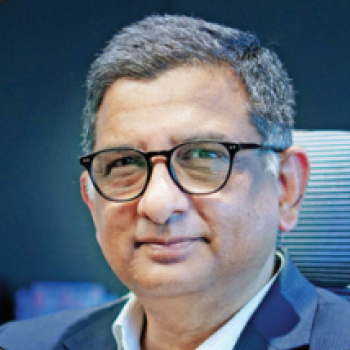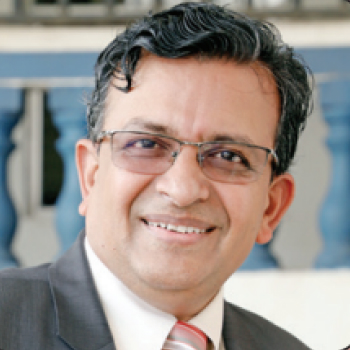Reverse Mentoring A win-win all round

With digital transformation and the speed at which businesses are changing and developing, organisations are facing a disconnect between their older and younger employees. Bridging the gap between generations within an organisation has become a big challenge. Reverse mentoring is becoming an effective way to connect the old and young employees and to bring in fresh ideas and different ways of strategies. As against the traditional norm of a senior manager guiding his junior, Reverse mentoring is about a senior leader being mentored by a junior employee, recognising that there are skills gaps and opportunities to learn on both sides of a mentoring relationship. A pertinent question is how to get reverse mentoring right, wherein the power dynamic of the traditional format of mentoring is flipped. Corporate Citizen talks to some of the seasoned corporate leaders, to know the many ways reverse mentoring can benefit an organisation, to build an inclusive workplace that factors in all people equally
Two-way street that benefits both
-Manu Saale,
MD and CEO, Mercedes-Benz Research and Development India (MBRDI)
This model of mentoring can also challenge the notion of mentoring being elitist, as it is not about a senior person taking someone under their wing, but a formal relationship for the purpose of skill sharing and professional development. The objective is to help the senior colleague develop new skills and connect with the younger generation.
HOW REVERSE MENTORING STARTED AS A WORKPLACE LEARNING THEORY
We can credit the idea of reverse mentoring to Jack Welch, who was the CEO of General Electric (GE) in the late nineties. Most companies during this time were keen to harness the power of the online world. But unfortunately, their senior employees didn't know how to navigate this new way of working. To overcome this problem in GE, Jack Welch asked 500 executives to find new joiners who they could learn from. It was this event that marked the very first reverse mentoring exercise. Since its development, reverse mentoring has evolved, just like other workplace learning theories.
Opportunity to assimilate knowledge from a different generation
-Peyush Bansal,
Co-founder and CEO, Lenskart
Reverse mentoring provides senior executives with the opportunity to assimilate knowledge from a different generation. One outcome is that the organisation becomes a self-learning organisation, but the biggest outcome is that we have a very engaged workforce across levels. Younger workers may not have the professional experience of their potential mentees, but their understanding of new media and technology is vast, native and adaptive.
The term ‘Reverse Mentoring’ is a Misnomer
-Lila Poonawalla
Industrialist,
Philanthropist, Humanitarian and Founder, Lila Poonawalla Foundation
If you want to be successful, upward mentoring is definitely the need of the hour. It largely means getting seniors to get acclimatised to new technology which the young corporate managers are very adapt at. This is absolutely necessary, otherwise the organisation would be left behind. In the absence of being armed with the latest technology, the CEO or any other senior manager would get frustrated and could vent anger on his team members due to his own inadequacies. This would finally adversely affect the growth and progress of the organisation.

However, I have a problem with the coinage of the word 'Reverse Mentoring’. As, this almost implies that the junior should be treated as the boss of the CEO or any other senior corporate leader. It could amount to hurting the ego of the senior or belittling him or her in front of the senior. I think some other word should be used which will effuse affinity and gentle guidance by the junior to the senior.
I remember when the computers came in newly, it was a young girl who taught me its nuances. So, we cannot call this ‘Reverse Mentoring’ – she gently took me through the whole process and we had such a healthy interaction.
In order to inculcate this new mode of work, let us not forget that seniors have put in decades of hard work and instead of straightaway saying they need mentors, we should take care of their sentiments and honourably make them realise that they would be far behind if they do not accept inputs from the young employees who are racing ahead in technology.
Let the power pass to the youth
-Ganesh Natarajan,
Executive Chairman and Founder, 5F World; former CEO, Zensar Technologies
It was 1991 and my first role as CEO at APTECH. Seeing the problems facing the company, I must have had a furrowed brow when I walked out of my office. A young woman, Mercy Paulose accosted me and said “Smile! you are the new CEO, and everybody is watching.”

Sixteen years later, after two successful leadership stints at APTECH and then Zensar Technologies, I was talking to our new team at 5F World about building a patented AI enabled skills platform and some of the ideas seemed outlandish. Another young woman, Nandini Sethi admonished me, saying “Remember Ganesh, impossible is nothing.” When we got our patent for 'Skills Alpha' last week, I acknowledged my young mentor.
These are the days of the millennials and Gen Zs and any leader who believes he can teach them everything they need to know, should think again. Being reverse mentored by youth, as indeed I have enjoyed for over twenty-two years, brings a breath of fresh air to thinking and enables both articulation and action to be contemporary and oriented to success.
Today, reverse mentoring is an imperative with fast changing demand and supply environments, when no young confident person wants to be hectored by a grey-haired know-all with a “When I was your age” attitude. Leaders must listen to youth often and well, and encourage even iconoclastic comments that disrupt the carefully nurtured status quo.
A classic example is the development of vision communities at Zensar where young people were encouraged to develop new strategies for the firm. It caused a new culture to emerge with senior folks allowing themselves to be mentored with new entrants and yet providing a light mentoring touch to ensure that freshly crafted ideas reached fruition.
Embrace reverse mentoring, let the power pass to youth and indeed you will find that new vistas open up and “impossible is nothing”.
Embrace reverse mentoring for a dynamic learning culture that values diversity, promotes inclusivity and drives innovation
-Srinivas Rao Mahankali (MSR),
CEO, T-Hub
Reverse mentoring programme must be an integral part of any organisation today because addressing the digital skills gap, ensures senior leaders hear from younger, digitally-gifted staff and vice versa. It encourages diversity and inclusion, challenging the traditional hierarchical nature of workplaces. It allows freshers to voice their ideas and viewpoints, making the work culture more inclusive.

How to get it right
To successfully implement reverse mentoring where a fresher can mentor senior leaders, it's crucial to define clear goals and expectations, and establish the purpose of the programme, such as digital skills development or diversity and inclusion, and set measurable objectives. Provide training and support, equipping mentors and mentees with communication skills, feedback techniques, and strategies to navigate challenges like power dynamics. Foster open communication and trust, by encouraging participants to approach the relationship with an open mind, value each other's experiences and viewpoints, and senior leaders must be receptive to learning from their junior colleagues. Emphasise mutual benefits, highlighting the reciprocal learning opportunities for both mentors and mentees, both interpersonal and professional skills.
Personal and business benefits
Reverse mentoring offers significant personal and business benefits that can create a lasting impact within an organisation. It bridges the skills gap while fostering diversity and inclusion, providing a platform for freshers to share their diverse perspectives, breaking down hierarchical barriers and promoting a more inclusive work culture. This leads to increased innovation, creativity and employee engagement-helps in developing future leaders, wherein a fresher can hone their leadership skills by mentoring senior executives. This boosts their confidence, visibility and career progression within the organisation. Reverse Mentoring improves employee retention—freshers will feel valued and heard, significantly improving morale and reducing attrition, especially among millennials and Gen Z. It builds a learning culture by encouraging learning and knowledge sharing across generations, creating a dynamic organisational culture that values diversity and continuous improvement.
Being mentor and being mentored
Senior leaders can play the role of both mentors and mentees by embracing a reverse mentoring approach. This involves freshers mentoring senior leaders on specific skills or topics, such as digital literacy or diversity and inclusion. This approach is a win-win for both parties. Senior leaders (mentors) gain valuable insights and skills from their mentees, ensuring they stay up to date with the latest trends and technologies enhancing their leadership capabilities and to have a better connection with the freshers. Freshers (mentees) can gain confidence and visibility by mentoring senior leaders, helping them to build a network of influential contacts within the organisation. Senior leaders can create a culture of lifelong learning, foster inclusivity and drive innovation, promoting mutual growth and development, ultimately benefiting the organisation as a whole.
Building a learning organisational culture
Reverse mentoring significantly benefits in building a learning organisational culture and improving cultural competency by encouraging and fostering a culture of lifelong learning, and encouraging diverse backgrounds to interact and learn together, leading to increased productivity and employee self-esteem. It fosters diversity and inclusion, providing opportunities for underrepresented groups to gain face-toface time with leaders, making themselves more visible within the organisation, and developing their careers. It helps break down stereotypes associated with different generations within the workplace, challenging ageism and enabling employees to connect and learn more about each other. Reverse mentoring encourages all employees to unite and create a shared learning experience, promoting mutual growth and development, and ultimately benefiting the organisation.
Reverse Mentoring is win-win for both
-Rajiv Mitra,
CEO and Director, Prabhat Dairy
Reverse mentoring is the opposite of traditional mentoring, where a senior leader is mentored by a younger, junior employee. The process recognises that there are skills gaps and opportunities to learn on both sides of a mentoring relationship.
Reverse mentoring was popularised by Jack Welch in the late 1990s. One of the pioneers of reverse mentoring in India is Bharti Airtel. I remember having a structure around it, during my days there in the early 2000s. Today, many organisations have a formal ‘reverse mentoring’ programme. As it is said, what can’t be measured, can’t be improved. Hence, the need for a formal reverse mentoring programme.

A formalised programme identifies the gaps, lays down a structured mentoring process, tracks progress that ultimately aligns with the organisation’s larger goals and ambitions. Traditional mentoring is an age-old, successful model of mentoring and training. Traditionally a mentor is expected to be more senior and more experienced than his/her mentee. However, in today’s day and age of frequent changes and upgrades in technology trends, geo-political equations, regulatory obligations, competitive challenges and consumer behaviour, it is imperative that we create a very adaptive and flexible business model.
Reverse mentoring, alongside traditional mentoring helps in closing the knowledge gaps and brings best of both worlds together to create a business that adapts to changes faster.
One is not at the expense of the other, both traditional and reverse mentoring have their place under the sun.
While mentoring in the reverse, both senior and junior employees gain enormously. Seniors add to their knowledge and skills level and breaks down harmful stereotypes about different age groups. Starters provide fresh perspectives and ways of working, while long-serving team members are likely to possess a wealth of organisational and industry knowledge, from which the juniors can benefit. By mentoring seniors, the juniors get a sneak peek into the lives of people much higher on the corporate ladder that may well prepare them for their future roles. Organisationally, it is a winwin-win i.e., it works for the mentor, mentee and broader organisational goals.
Any mentoring process, be it reverse or traditional, works on a culture of willingness to learn. For seniors, curiosity and thirst for knowledge needs to remain alive. And, the junior mentor must be keen to share knowledge and skills and that too in a way that is intelligible to someone a generation or two apart. It creates harmony, respect for individuals for their skills, irrespective of hierarchical levels and creates an overall culture of caring, sharing and inspiring. A culture of merit takes over culture of entitlement.
Reverse mentoring creates resilient and innovative workforce
- Girish Gadamsetty,
Director, Business
Operations, Adobe
In an era where access to a skilled talent pool is of immense strategic importance, reverse mentoring provides a unique avenue to leverage the capabilities of both senior and junior employees.

Access to skilled talent pool is of immense strategic importance today. A diverse workforce, particularly women returning to work after family commitments, can greatly fill this talent gap.
Often they are skilled and mature but traditional job-finding methods may not be effective for these women. Instead, internships supported by reverse mentoring programmes allow them to reintegrate at a manageable pace, while demonstrating their capabilities. Junior employees, well-versed in current technologies, can mentor these interns, facilitating a valuable exchange of technical skills and at the same time, the junior employees benefit from the mature interns' life experiences and insights on planning career breaks, which are often inevitable. If these interns demonstrate excellent results, they are onboarded as regular full-time employees. Flat matrix structures are rapidly replacing hierarchical organisations. In startups, the majority of the staff are often young engineers working under a few experienced leaders. In both scenarios, reverse mentoring is instrumental in helping organisations thrive. Through reverse mentoring, experienced leaders gain insights into the working styles and preferences of young engineers, enabling them to better inspire and support their teams. Simultaneously, young engineers, while acting as mentors, also become mentees and gain confidence, leadership skills and a broader understanding of organisational dynamics. This reciprocal learning fosters a dynamic and effective organisational environment.
From a business perspective, reverse mentoring fosters innovation by encouraging diverse viewpoints. Senior leaders can better connect with younger consumers by understanding their preferences and behaviours. This knowledge can drive the development of more relevant and appealing products and services. Often new-age solutions involve skills such as the latest digital trends and social media strategies, which are more commonly associated with the younger generation.
Unlike traditional mentoring, reverse mentoring flips the power dynamic, which can be challenging to navigate, hence it is not a popular choice among most organisations yet. Success requires creating an environment of mutual respect and openness. Seniors must be willing to learn from junior mentors, and juniors must feel empowered to share their knowledge with seniors. Both seniors and juniors need to understand the objectives of the mentoring relationship and how they can mutually benefit from it. Reverse mentoring helps build a learning organisational culture where knowledge flows in all directions. This fluid exchange of ideas encourages employees at all levels to continually develop their skills and stay updated with industry trends.
Reverse mentoring is a win-win strategy that benefits both individuals and organisations. It bridges the gap between generations, fosters mutual respect, and drives innovation. Senior leaders can simultaneously play the roles of mentors and mentees, creating a dynamic where everyone grows and thrives. By embracing reverse mentoring, organisations can unlock the full potential of their diverse talent pool and create a resilient, adaptable and innovative workforce.
Reverse Mentoring—to foster innovation and develop well-rounded leaders
- Dr Deepak Shikarpur,
Director, Kinetic
Communications Ltd
Paradigm of Age and experience in 21st century are different than previous centuries. Earlier, knowledge and information were closed, restricted and only way to gain knowledge was to read books. Now, with advent of technology, information is everywhere and anyone can learn anything. This is where organisations need to reinvent concept of knowledge management. Another popular concept is hire a consulting firm who will impart you certified knowledge. This model may work in some domains, but can’t be trusted in all situations. Many grandparents have learnt how to operate digital devices from grandchildren. So, age is not everything. Learning in 21st century is unlearning+relearning— what is the use of irrelevant knowledge.

Organisations today need to have a formal programme in place for reverse mentoring, as persons can learn from anywhere. Today’s corporate workforce has a vast generational spread. Reverse mentoring allows senior leaders to gain insights from younger employees who are digital natives and bring fresh perspectives on areas like social media, technology and innovation.
Learning some things from seniors, especially human behaviour and customer relations, is equally important. What about things which are nondigital. Hence conventional age old mentoring is also important. Organisations need to blend both models of traditional mentoring and reverse mentoring.
The personal and business benefits of reverse mentoring are that younger employees can challenge the status quo and inject fresh ideas. This crossgenerational exchange can lead to more creative solutions and help companies stay ahead of the competition.
The hierarchical structure in some Indian companies might make it challenging for senior leaders to accept being mentored by younger employees. Unless organisations adopt Flat Leadership Model, they can’t adopt to Reverse Mentoring. This is where Situational Leadeship and need based organisational structures are important.
Reverse mentoring can benefit in building a learning organisational culture and improving cultural competency, but finding the right fit between senior leaders and younger employees is important. Shared interests and clear goals for the programme will enhance the learning experience.
Overall, reverse mentoring offers a unique opportunity for Indian corporates to bridge the generational gap, foster innovation, and develop well-rounded leaders. By addressing cultural challenges and ensuring proper programme design, companies can reap the benefits of this valuable approach.
A powerful tool to keep learning and growing
-S V Nathan,
Co-founder and Chairman, Visara Human Capital Services

The world is moving at phenomenal pace and if you look at what’s happening to skills—skills are exploding. The half shelf-life of skills is about around 4 years. For IT skills it is 3 years. So, that which you learnt four years ago is no longer relevant. That being the pace of change, if leaders have to lead a team, who are smarter than them, far cleverer than them, far more accomplished in what they are doing, then it is incumbent on the leader to be worthy of leading a pack of highly talented people. And, for them to respect somebody, that person must know a little bit about that subject. No person can be a subject-matter-expert in everything along the way. So, the best answer is that if you don't know enough, you either seek information, which is easy today—you read and watch things, or hear people speak. But if you want to build a culture of learning within an organisation, reverse mentoring is one of the most powerful tools. What is being said is that in a very subtle way 'I am putting aside my ego, I am willing to learn and I am willing to learn not from somebody who is superior to me by age and stature, but from somebody who reports to me, who could be far more junior to me' and that is okay.
Reverse mentoring has a lot of other advantages, the biggest of which is that you keep learning and growing and of course even the organisation grows because it’s the culture. To bring reverse mentoring into practice in an organisation, you have to institutionalise it. You have to create a project Reverse Mentoring and it’s got to be led by leaders, who will volunteer for this. And, if there are two-three success stories, that’s the best and all that is needed.
Change is a constant and learning our insurance against obsolescence
-Ravi Krishnamachari,
CEO, Raas Intellisolutions LLP

Reverse mentoring is not new; I am all for organisations and individuals embracing it. The two-way flow of wisdom is a fact of this new-age world. It is something that we experienced when mobile phones, apps came into our lives. Children picked them up fast, as younger people usually pick up new inputs quickly, and we approached them for help. All of a sudden, the roles got reversed.
This is exactly what is happening in the workplace. Change is a constant and learning our insurance against obsolescence. The younger generation, having grown up in the internet age, has exposure to a wide range of experiences and insights that the older generation does not. Hence, the older generation must not hesitate to learn. Learning is a two-way street.
A strategic investment in organisational agility, innovation and long-term success
-Raj Kapoor,
Founder, India Blockchain Alliance (IBA)
It is critical today for organisations to implement a formal reverse mentoring programme, to harness the knowledge and skills of younger employees, particularly in areas such as digital proficiency and contemporary cultural trends, to enhance the competencies of senior staff. This structured approach ensures consistent and impactful exchanges, leading to improved technological adoption and innovative thinking at all levels of the organisation.
Additionally, a formal programme promotes a culture of inclusivity and collaboration, bridges generational gaps, and embeds respect and understanding thereby enhancing workplace harmony. This prepares the next generation of leaders while refreshing the perspectives of current leadership. Ultimately, a formal reverse mentoring programme is a strategic investment in organisational agility, innovation and long-term success.
To get it right when it comes to reverse mentoring, the first step would be to clearly define the objectives— establishing a structured framework with regular, agenda-driven meetings and well-defined roles will help maintain focus and consistency. We need to prepare participants with comprehensive training to address expectations, communication styles, and navigate flipped power dynamics. Vital to success are regular feedback mechanisms to monitor progress, resolve issues, and course correct the programme as and when needed. Recognition and reward for participation is a strong motivator as this highlights the programme's value and encourages commitment. This would not just build bridges between generational gaps but would also promote inclusivity and reduce probable friction
On a personal level, reverse mentoring enhances the skills and knowledge of senior employees by introducing them to new technologies and modern work practices. On the other hand, younger employees gain confidence and a greater sense of value.
From a business perspective, reverse mentoring drives innovation and creativity by embedding fresh perspectives into problemsolving processes, enhances talent development by identifying and nurturing emerging leaders, and promotes inclusivity by breaking down hierarchical and generational barriers. By preparing the next generation of leaders and refreshing current leadership, reverse mentoring secures a robust, adaptable and forward-thinking organisational environment.

As mentors, senior corporate leaders share their vast experience, strategic insights, and leadership skills with younger employees, catalysing the development of future leaders and contributing to talent growth within the organisation. At the same time, as mentees in reverse mentoring arrangements, they gain fresh perspectives, technological proficiency, and an understanding of modern trends from their younger counterparts. By participating in both roles, senior leaders remain adaptable and relevant in a rapidly evolving business landscape, and younger employees feel valued and empowered. This reciprocal relationship drives innovation, bridges generational gaps, and strengthens communication across the organisation, ensuring a dynamic and inclusive workplace.
Reverse mentorship involves pairing younger, more digitally and culturally savvy employees with senior leaders to facilitate a two-way exchange of knowledge and perspectives. This dynamic approach promotes a culture where learning is valued at all levels. This exposure helps dispel stereotypes and biases, leading to a more inclusive and culturally sensitive workplace.
Without reverse mentoring, the company has limited shelf life
-Ninad Karpe,
Partner, 100X.VC

A formal programme for reverse mentoring ensures that it gets done. People are motivated differently, when there is a structure and process—hence the need for business organisations to initiate it.
Yes, the power dynamics is flipped but the knowledge dynamics are unstoppable. The younger mentor has more contemporary knowledge, more information on the latest technologies and consumer behaviours. The older mentee has no choice but to eat humble pie and listen. If the reverse mentoring doesn’t happen, the company will have a limited shelf life and be overtaken by the competition. Unless the knowledge flow goes from “young” to “not so young,” the winds of change will blow you away.
If reverse mentoring is done in a proper manner, it can benefit the learning culture in an organisation, and will be a win-win for all. The older leaders can share nuggets of wisdom and the younger ones can share their knowledge.
Reverse mentoring breaks down silos and encourages open communication
-Aman Rajabali,
Chief Everything Officer, Kabir Profile Solutions and President NHRDN – Pune Chapter
Annual or weekly meetings where everyone learns from each other, isn’t it amazing— that’s what reverse mentoring does. In today’s fast paced world, fresh perspectives are more valuable than ever. Reverse mentoring programmes create a space for exchange of expertise. Younger workers bring new ideas, digital fluency and understanding of current trends. A senior employee in turn share their wisdom, industry knowledge and problem-solving skills. It’s a win-win for everyone— this exchange fosters innovation, bridges the generation gap and helps productivity improvement.

Have a chat beforehand to set expectations. Make everyone feel like they can share freely, regardless of experience. You, as junior might teach social media tricks, while your senior colleague or manager offers wisdom on navigating tricky situations—like a two-way street. Regular check-ins keep things on track, and supportive environment ensures everyone feels valued. This flipping dynamic can create win win for personal and company’s success.
For the personal benefit of junior employee, it’s a chance to shine, get to share his/her expertise, build confidence, and may even spark new ideas. On the other hand senior folks gain fresh perspectives, stay on top of trends and learn new valuable digital skills. But the benefits go beyond individuals. Reverse mentoring fosters a culture of open communication and breaks down silos, young voices get heard—this creates innovation and company stays ahead of competition.
A company leader of wisdom and a teachable spirit, can absolutely rock the dual role of mentor and mentee. As mentors, they share their valuable experience and guide younger colleagues at the same time learn from fresh perspectives. Reverse mentoring allows them to tap into the digital fluency and innovative thinking of younger generations. This two-way street fosters a culture of continuous learning, breaks down hierarchies and positions the company for improved productivity. This dynamic and successful organisational change allows to learn from everyone next to them.
A company has culture where everyone learns from each other, regardless of age or background. That’s the magic of reverse mentoring. Creating a space by senior leader, junior employees can swap their knowledge, fostering a culture of continuous learning. This helps to gain confidence in the junior employees to share insights, and senior folks stay sharp by picking up new skills and perspectives.
Surely, benefits go beyond individual development, as it breaks down silos and encourage open communication. As junior employees from diverse backgrounds share their experience, this improves cultural competency. The company gains a richer understanding of its workforce and market it serves. This helps creating more inclusive and dynamic environment.
Reverse mentoring is the way ahead, embrace it
-Sajeev Nair,
Founder Chairman and CEO, CHRS and ASSET; Former Senior Vice
President (Learning and Development), Reliance Industries Ltd

A traditional mentor is a guide or teacher who imparts knowledge to their juniors. Reverse mentoring deviates from traditional mentoring by encouraging juniors to share their insights with seniors. This exchange of knowledge, regardless of the direction, is valuable and motivated too. Age is just a number, and juniors often possess ample knowledge, especially in today's rapidly evolving times into the digital world. Reverse mentoring is an intriguing concept, though unconventional and not yet fully embraced, it remains a fact. Various types of mentoring are happening, and reverse mentoring is among them.
There are two primary challenges in reverse mentoring. First is the mentor-mentee mismatch. It is crucial to have the right discipline and mutual respect, ensuring that the mentor and mentee’s personalities and vibes align. The new generation has many brilliant ideas and their exposure to the digital world is impeccable—we should capitalise on this. The second challenge is the hierarchy difference. Ultimately, we all work for the betterment of the organisation and must embrace this concept, keeping the differences aside. By doing so, we empower the new generation, leading to increased retention.
It's time to stop avoiding reverse mentoring and start accepting it. The sooner we accept and implement this practice, the better it will be for the growth and adaptability of our organisations. Reverse mentoring not only bridges the generational gap but also fosters a culture of togetherness, continuous learning, and innovation, benefiting everyone involved.
Reverse mentoring – The right approach for modern organisations
-Ankita Singh,
Chief People Officer and Board of Directors, CIGNEX and Relevance Lab;
Founder, HR Association of India

In today’s era, mentoring is not just about experience or tenure, rather it is more than that. And, it is only now that people are appreciating and accepting it. Reverse mentoring is nothing traditional or conventional. I strongly feel that it represents the right approach, prioritising capability over experience. For instance, technology is an area where our junior colleagues often excel more than us. It's not solely about experience here, but also about familiarity, accessibility, associability, better understanding, and a fresh approach, all of which we should embrace.
Reverse mentoring plays a crucial role in bridging generational gaps within the organisation. It supports the breakdown of stereotypes associated with different generations in the workplace, challenges ageism, and enables employees to connect and learn from each other. By removing assumptions and barriers, reverse mentoring encourages all employees to unite in creating a shared learning experience.
In fact, this kind of mentoring helps organisations focus on what truly matters instead of just following popular opinion. This further cultivates a holistic learning environment where knowledge and capability form the foundation for creating a more robust yet adaptable platform.
When executed correctly, reverse mentoring can effectively develop talent. I am utilising an acronym of the word REVERSE to stress how the process of reverse mentoring should yield maximum benefit: Relatable, Empowering, Versatile, Effective, Responsive, Synergistic and Evolving.
Many organisations have launched extensive reverse mentoring programmes. Sometimes, challenges arise due to entrenched mindsets and friction, but it is what it is.